 By Tami G. O’Connor
By Tami G. O’Connor
When I taught second grade, one of our literature books was Mirette on the High Wire by Emily Arnold McCully. I was that teacher who always taught thematically—that is, nothing ever was taught in a vacuum. I tried as often as possible to tie things together.
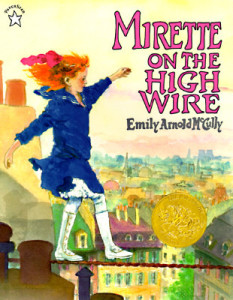 So as we read this book about a young French girl who learns from a retired high-wire artist to walk on a tightrope, in Language Arts we talked and wrote about our heroes, in Geography we researched where in the world France is. And in Science, we learned about balance and center of gravity.
So as we read this book about a young French girl who learns from a retired high-wire artist to walk on a tightrope, in Language Arts we talked and wrote about our heroes, in Geography we researched where in the world France is. And in Science, we learned about balance and center of gravity.
Even young children know that if you hold something above the ground and release it, the object falls. This is due to gravity. Gravity is the force that pulls all objects on Earth downward. Center of gravity is simply defined as the point where the mass (the stuff things are made from) of an object is concentrated.
This point of concentration is where an object balances. For example, if you take a Popsicle stick and tie a string around it, the stick will balance when the string is located at its center of gravity. For a simple object like a Popsicle stick, the center of gravity is located right in the middle of the stick. If you tie the string too far on one side or another, the stick will not balance.
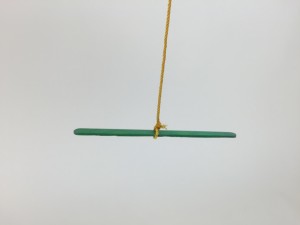
But what happens if you add a pea-sized lump of clay to the same Popsicle stick that just balanced perfectly when the string was tied directly in the center? Like a seesaw, the stick tips in the direction of the added weight. In order to rebalance your stick, you will need to slide your string closer to the weight.
The result is that in order to balance, the stick will be longer on one side of the string than the other. In this case, the students can easily see that the center of gravity moves toward the added weight.
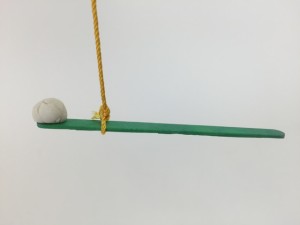
For more complex shapes, the center of gravity is not as easy to find. If you look at the human body, the center of gravity is actually found a little above the waist. This is because there is more mass above your waist than below it.
While teaching Mirette on the High Wire, I would demonstrate the Popsicle stick and string. Next, I asked the Physical Education teacher to pull out the low balance beam and have the kids explore walking on it with their arms at their sides versus holding their arms outstretched, with and without weights. The result was always greater interest by my students and therefore greater understanding of the concepts presented.
One of the activities I did with my students was a science/art project in which we made Balancing Men. You can make your own tightrope-walking men or ladies from Popsicle sticks, pipe cleaners and a pair of washers. Colored markers and googly eyes are optional, but add a lot of cute balancers! These balancing people were simple to make even for younger learners.

Student were able to experiment with how wide apart they needed to place the arms in order for their little men to balance. Once they mastered having their “walkers” balance upright, I challenged them to balance their Popsicle stick so it was horizontal. This led to plenty of discussion on center of gravity and why tightrope walkers use poles to balance themselves as they walk.

As an extension, we also made balancing birds.
Materials:
manilla file folders
balancing bird template (click on image for printable PDF template)
2 coins (nickels or quarters)
tape
scissors
crayons or colored pencils (optional)
If you would prefer not to have your students make these designs, or if you’d like a more durable example of center of gravity for your science table, Educational Innovations carries a number of engaging products that students find fascinating!
 Balancing Bird Demo
Balancing Bird Demo
This eagle balances on almost anything – your finger, a pencil, or the edge of your desk. Its center of mass (or center of gravity) is generally beneath the tip of its beak. Students can change the eagle’s center of gravity by adding small pieces of tape or paper clips to have it balance perfectly. Our proud bird can even be used to demonstrate rotational inertia! Just balance it on a pencil above your head, and turn around 360 degrees. The bird will remain in the same orientation due to its fairly large moment of inertia.
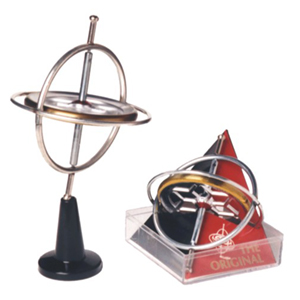 Classic Gyroscope
Classic Gyroscope
The toy gyroscope has been in production since 1917 and has been a classic educational tool for generations. Use the power of physics to balance the gyroscope on its pedestal, a fingertip, the edge of a glass, or even a string. Gyroscopes are used in robotics, space exploration, and they are even used to stabilize movie cameras. Each gyroscope is packed in a clear styrene box with starting string, pedestal, and instructions for several amazing tricks. Measures 4.75 inches tall.
The PhiTOP
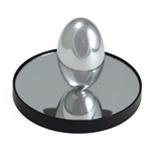 We’ve fallen in love with the PhiTOP, and bet you will, too! This beautifully crafted top does for angular momentum what Newton’s Cradle does for linear momentum. When spun, it starts out horizontal and then, surprisingly, stands upright. Wow! In the process, it illustrates the difference between equilibrium and stability. The rise of the ‘center of mass’ is a fascinating physics problem. It will spin for minutes on end, producing a marvelous optical illusion as it slows down. Invented by astrophysicist Kenneth Brecher, the PhiTOP encourages exploration of force, mass, density, gravity, friction, and time. In short, the PhiTOP is an elegant scientific, mathematical, and aesthetically-pleasing object that makes a perfect gift, desktop display piece, or student stumper. See for yourself in our video! Egg is ~5 cm tall (2 in.)
We’ve fallen in love with the PhiTOP, and bet you will, too! This beautifully crafted top does for angular momentum what Newton’s Cradle does for linear momentum. When spun, it starts out horizontal and then, surprisingly, stands upright. Wow! In the process, it illustrates the difference between equilibrium and stability. The rise of the ‘center of mass’ is a fascinating physics problem. It will spin for minutes on end, producing a marvelous optical illusion as it slows down. Invented by astrophysicist Kenneth Brecher, the PhiTOP encourages exploration of force, mass, density, gravity, friction, and time. In short, the PhiTOP is an elegant scientific, mathematical, and aesthetically-pleasing object that makes a perfect gift, desktop display piece, or student stumper. See for yourself in our video! Egg is ~5 cm tall (2 in.)
Bring a refrigerator magnet next to a PhiTOP that is made from a non-magnetic metal such as aluminum or brass while it is spinning and it will slow down and stop. This is a simple demonstration of the magnetic induction principle that underlies Nikola Tesla’s famous 19th century Egg of Columbus demonstration that led directly to the acceptance of AC electricity over DC. The original 19th century apparatus employed a rotating 3-phase magnetic field configuration with no moving parts to spin up a copper egg shaped object.



Thank you! This was great!!